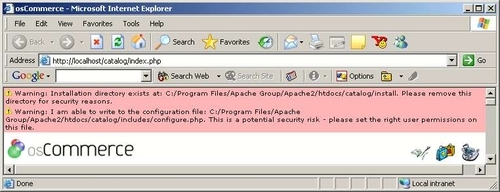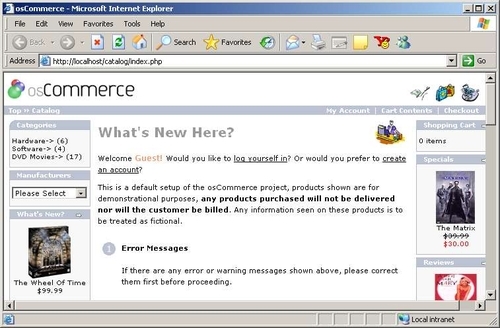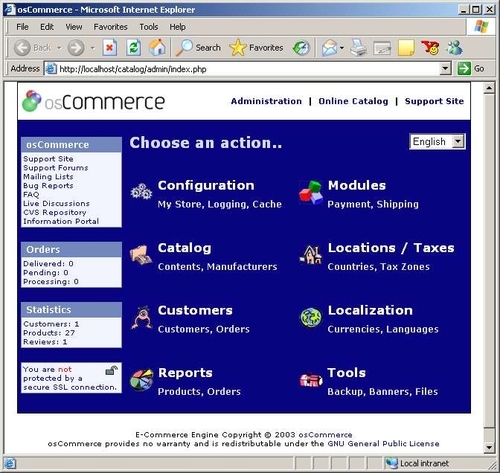With osCommerce installed now, one might be forgiven for breathing a huge sigh of relief because everything has been done and the universe is unfolding as it should. Of course, I urge you to click on the Catalog option on the final installation window in order to get a reality check. You will no doubt find that the page that is brought up spawns some horrid-looking warnings before actually displaying anything that could be mistaken for an online shop, much like this:

Don’t worry, though! We’ll quickly talk about how we can make these warnings disappear.
Note
Some of you may have noticed that the URI in the previous screenshot says localhost instead of www.contechst.com. This is because, for the purposes of testing, much work was done on the author’s own machine and not on the live site. This doesn’t affect you at all and you will be able to follow along on your own hosted site regardless.
To begin with, the first warning tells us that the install directory exists within the catalog folder, and we are asked to remove this for security reasons. Well, OK! They’re the boss. Navigate to the install directory on your file system and remove it from the catalog folder.
Once that is done, we can turn our attention to the next warning, which tells us that we have a potential security risk in the form of a writeable configuration file. Of course, we never, ever want anyone other than ourselves to be able to write to any configuration file on our own system, so this warning is certainly an important one.
Navigate over to the configure.php file on your file system—you can find the file by reading the warning given in the browser; it will tell you the file path of the file in question. Once there, you will need to change the permission settings of that file so that it is not writeable as shown here:

With those two configuration changes made to your osCommerce installation, I’ll wager that everything is now in pretty good working order; refresh your catalog index page in your browser or navigate to http://www.<domain_name>/catalog/index.php if you have closed it down already. You should now find that you are presented with a demonstration site, which is free of any warnings (for the meantime). The index page should look like this assuming everything is working properly:

If this is the screen you have reproduced on your machine, then you can be certain that everything is shipshape and raring to go. Because osCommerce does most of its own setup, we shall not spend too much time testing everything at the moment. There is, however, a troubleshooting section at the end of this chapter, which will run through some of the more common problems that people encounter on the road to online success.
Before we do continue, though, you might well be curious to see what the administration tool looks like. If this is the case, either click the Administration Tool option given on the final page of the installation, or navigate to http://localhost/catalog/admin/index.php. In either case, you should see your admin tool, all shiny and new:

From here, you will be able to perform pretty much any administrative task your heart could desire. Everything is neatly categorized, very well laid out, and intuitive to use. We will be looking at how to customize our site in Chapter 3, where we show how to use and find your way around this impressive tool. For now though, it is good enough to know that it is there ready for use.
